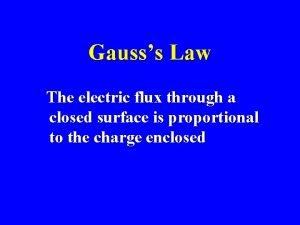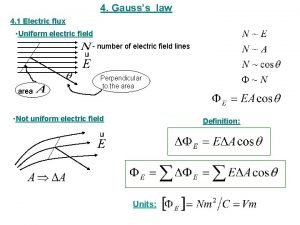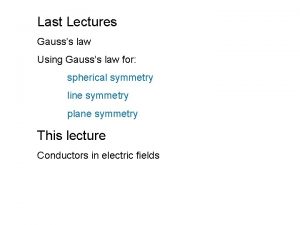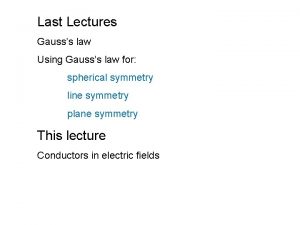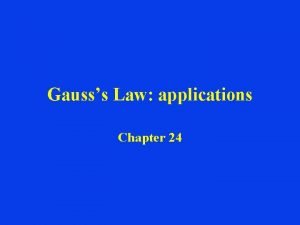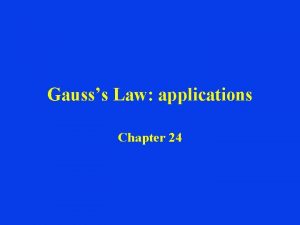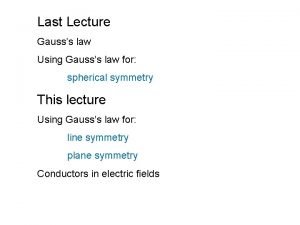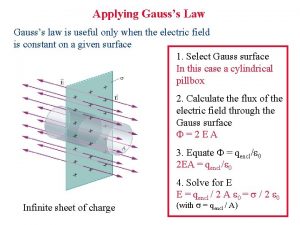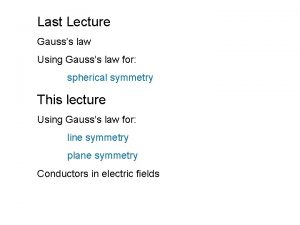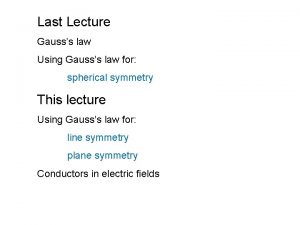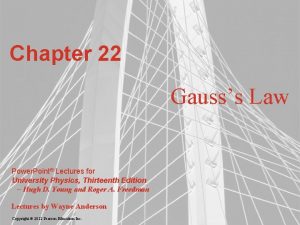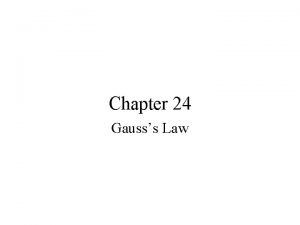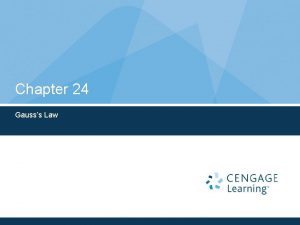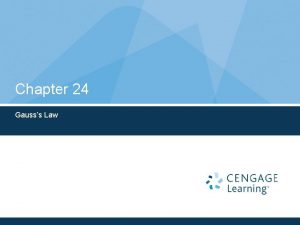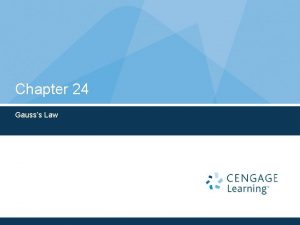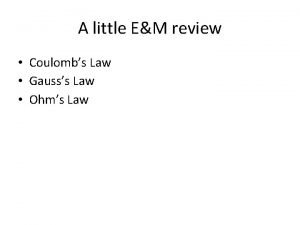Chapter 22 Gausss Law Power Point Lectures for






















- Slides: 22

Chapter 22 Gauss’s Law Power. Point® Lectures for University Physics, Twelfth Edition – Hugh D. Young and Roger A. Freedman Lectures by James Pazun Copyright © 2008 Pearson Education Inc. , publishing as Pearson Addison-Wesley

Goals for Chapter 22 • To study electric flux • To calculate electric flux with Gauss’s Law • To consider the electric field of various symmetric charge distributions Copyright © 2008 Pearson Education Inc. , publishing as Pearson Addison-Wesley

Introduction • The movement of electrons can be shocking (pardon the pun). • If you look at the girl’s hair (figure to the right), you’ll see the electrons coating each individual hair fiber and then repelling each other. • Gauss imagined a flow through a surface placed around a charge and then considered outcomes that we will study in Chapter 22. Copyright © 2008 Pearson Education Inc. , publishing as Pearson Addison-Wesley

Flux as the flow out of an imagined box • If we construct a boundary around a charge or charges, we can think of the flow coming out from the charge like water through a screen surrounding a sprinkler. Copyright © 2008 Pearson Education Inc. , publishing as Pearson Addison-Wesley

What happens as I change the conditions? • Consider +1 versus +2 or a box with double the containment dimension. Copyright © 2008 Pearson Education Inc. , publishing as Pearson Addison-Wesley

A measurement of flux will be sensitive to measurement • If we considered flux through a rectangle, the flux will change as the rectangle changes orientation to the flow. Copyright © 2008 Pearson Education Inc. , publishing as Pearson Addison-Wesley

Flux in a uniform field • Measurement of the flux for a uniform electric field Copyright © 2008 Pearson Education Inc. , publishing as Pearson Addison-Wesley

If the field is not uniform—the disk • Refer to Example 22. 1 to evaluate flux through a disk. • Figure 22. 7 illustrates this example. Copyright © 2008 Pearson Education Inc. , publishing as Pearson Addison-Wesley

If the field is not uniform—the cube • Refer to Example 22. 2 to evaluate flux through a disk. • Figure 22. 8 illustrates this example. Copyright © 2008 Pearson Education Inc. , publishing as Pearson Addison-Wesley

If the field is not uniform—the sphere • Refer to Example 22. 3 to evaluate flux through a disk. • Figure 22. 9 illustrates this example. Copyright © 2008 Pearson Education Inc. , publishing as Pearson Addison-Wesley

Gauss’s Law • The expression is an alternative to Coulomb’s Law. • The nifty thing about being a scientist in Gauss’s day is that you got to leave your name on clever work (not to mention the nice painting). Copyright © 2008 Pearson Education Inc. , publishing as Pearson Addison-Wesley

Flux through concentric spheres with different radii • Consider the flux as changing the radius of the sphere changes its volume. Copyright © 2008 Pearson Education Inc. , publishing as Pearson Addison-Wesley

Projecting flux through other shapes • Consider Figure 22. 12 to contemplate flux through nonspherical surfaces. Copyright © 2008 Pearson Education Inc. , publishing as Pearson Addison-Wesley

Effect of changing the sign of the charge • Figure 22. 14 leads us to consider the effect of changing the sign of our point charge. Copyright © 2008 Pearson Education Inc. , publishing as Pearson Addison-Wesley

There are practical applications • Figure 22. 17 treats excess charge as residing on the surface of a conductor. • Consider Example 22. 5. • Figure 22. 18 illustrates Example 22. 5. Copyright © 2008 Pearson Education Inc. , publishing as Pearson Addison-Wesley

The field of a line or plane of charge • Consider Example 22. 6 and Figure 22. 19. • See also Example 22. 7 and Figure 22. 20. Copyright © 2008 Pearson Education Inc. , publishing as Pearson Addison-Wesley

A field between parallel plates of opposing charge • The capacitor is the actual device. Copyright © 2008 Pearson Education Inc. , publishing as Pearson Addison-Wesley

The field of a uniformly charged sphere • Consider Example 22. 9. • Figure 22. 22 illustrates the example. • Follow Example 22. 10. Copyright © 2008 Pearson Education Inc. , publishing as Pearson Addison-Wesley

Charges on conductors • The electric field within a charged conductor may be found. • Consider Figure 22. 23. • Follow Example 22. 11 and Figure 22. 24. Copyright © 2008 Pearson Education Inc. , publishing as Pearson Addison-Wesley

Experimental tests of Gauss’s Law • Regard Figure 22. 25. • A metal container on an insulating stand. Copyright © 2008 Pearson Education Inc. , publishing as Pearson Addison-Wesley

The Van de Graaff generator • The source of all the static on the child’s hair in our introduction. • Consider Figure 22. 27 below. Copyright © 2008 Pearson Education Inc. , publishing as Pearson Addison-Wesley

A Faraday cage blocks flow • Refer to Figure 22. 28 below. • Science-fiction movies always place alien transmitters in these to prevent them from calling for help. • Follow Examples 22. 12 and 22. 13. Copyright © 2008 Pearson Education Inc. , publishing as Pearson Addison-Wesley
 Conclusion of gauss law
Conclusion of gauss law Gausss law
Gausss law Power system lectures
Power system lectures Power trianlge
Power trianlge Power bi training powerpoint
Power bi training powerpoint Point point power
Point point power Bubble point and dew point calculation
Bubble point and dew point calculation Newton's first law and second law and third law
Newton's first law and second law and third law Newton's first law and second law and third law
Newton's first law and second law and third law Boyle's law charles law avogadro's law
Boyle's law charles law avogadro's law Constant of avogadro's law
Constant of avogadro's law Rick trebino
Rick trebino Neonatology lectures
Neonatology lectures Data mining lectures
Data mining lectures Advanced medicinal chemistry
Advanced medicinal chemistry Uva powerpoint
Uva powerpoint Cs614 short lectures
Cs614 short lectures Planning a software project
Planning a software project Cell and molecular biology lectures
Cell and molecular biology lectures Radio astronomy lectures
Radio astronomy lectures Dr sohail lectures
Dr sohail lectures Utilities and energy lectures
Utilities and energy lectures Web engineering lectures ppt
Web engineering lectures ppt
